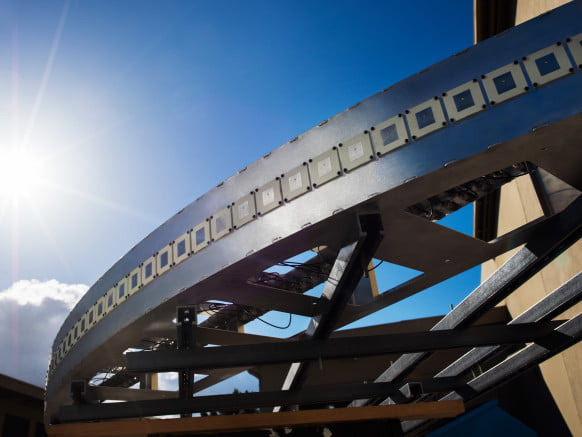Facebook now builds wi-fi antennas that could beam internet signals across towns and nicely past.
The ultimate week on the annual F8 Facebook fest in San Francisco, the agency unveiled different wireless antennas its engineers had secretly created internal its Connectivity Lab, a swashbuckling attempt to expand the attain of the net in such a lot of new ways. This type of antenna, dubbed ARIES, is designed to beam signals to rural areas from cities up to 2 dozen miles away. Consistent with facebook’s information, about 97 percent of the world’s population lives inside that radius, which might, in theory, allow ARIES to connect a majority of the people on this planet who’re now unconnected—and make sure they have the infrastructure they need to, nicely, use Facebook. Such antennas, fb says, are lots cheaper than stretching fiber and energy cables and so many tiny cell towers into those rural areas to deliver broadband the a82ee8a4ee179e54beacaecce0423cb2 way.

At the start blush, facebook’s competitive efforts to create networking hardware may also appear extraordinary for a corporation that’s all about social networking. But it doesn’t want to sell hardware. Facebook organization designs hardware to feed the boom of Facebook, the social community. And it hopes to force that growth with the aid of gifting away the designs—totally free.
Does this make absolutely make feel? Erik Ekudden is in an amazing role to decide. He’s the vice-chairman of approach at Ericsson, the Swedish multinational that builds a pretty extensive chew of the wireless antennas and different tools that underpin the world’s cell networks. In constructing its antennas and probable different equipment, facebook is treading on Ericsson’s territory. And by open-sourcing their designs, Mark Zuckerberg and the group may also grow to develop delivered opposition for the one hundred forty-yr-vintage Swedish corporations.
Read More Articles :
- In Norway, you could look up your neighbor’s income on the internet. It is a great idea.
- Things to Love About the iPhone
- Tony Cozier: West Indian commentator dies aged seventy-five mythical West Indian commentator Tony Cozier has died at the age of 75.
- On living with the Internet of Things
- Why I wouldn’t say I like the internet observed such a lot of readers
So perhaps not distinctly, Ekudden says that fb’s plan for ARIES isn’t as critical as it seems. by 2020, he says, the prevailing wi-fi enterprise will deliver the net to about 90 percent of everyone in the world by upgrading present wi-fi networks that provide telephone service but don’t yet supply information (that is, the internet). “The maximum green way to offer net connectivity for another one-and-a-half billion subscribers around the sector is simply to upgrade that infrastructure,” he says. “That’s a simple improvement to the one’s systems.”
In other words, we don’t necessarily need new antennas that could beam indicators from a metropolis and out into the encircling rural regions. some other five percent of the world’s population can be reached via 2020, he says, by using the usage of the present generation to increase the reach of existing networks. “just make the cells larger,” he says, “and upload more cells in villages with clusters of humans.”
Any manner online
The rub is that even if you attain 95 percent of the population, this still leaves the final 5 percentage. And even if this enlargement does occur by 2020—-that is hardly guaranteed—that’s still four years away. As Facebook sees it, gear like its ARIES antennas may want to both widen and accelerate the sort of expansion Ekudden expects.
fb, you notice, is attacking the edges of the problem—the rims that nobody else is definitely searching at. Nicely, no one else, except Google, which is building drones and balloons that could deliver internet get right of entry to the beneath-served regions simultaneously as floating through the stratosphere. Drones and balloons can attain regions that existing infrastructure can not.

The equal may be genuine of antennas like ARIES. In fact, later in our conversation, Ekudden factors out that Ericsson, among others, is building generation quite just like facebook’s extensive-range antenna. Meanwhile, Zuckerberg and organization are converting the equation through open sourcing their designs. And to a certain volume, Ekudden recognizes the power of this method. If more businesses work on the problem—and freely proportion their work with every different—the community can evolve quicker. “We accept as true with very much that obtaining enter, whether it’s open-source or standardization, is right,” he says. “together, we can do that.”
What’s extra, fb unveiled a 2d antenna at closing week’s conference. This one is called Terragraph, and it’s designed to improve wi-fi networks within towns. Instead of counting on fiber traces to attach cellular towers, or “base stations,” that send alerts to phones and other gadgets, the Terragraph connects base stations through indicators shifting through a touch-used part of the unlicensed airwaves.
Ekudden factors out that Ericsson and others are doing something comparable in different parts of the spectrum. However, again, Facebook goes after an area case, searching to increase the net in methods and places others may not be. As others explore the licensed spectrum, it’s exploring the unlicensed.
On the surface, fb’s methods seem extraordinary. And if you take a better appearance, they might seem redundant. Ekudden points out—again and again—that Ericcson and others are constructing stuff that’s no longer not like what Facebook has built. But in the long run, Facebook is working in an eminently rational way. Even supposing fb’s tools is similar to what others are already making, open sourcing the designs can unfold such tools speedy and cost-effectively—that can force the Ericssons of the sector to transport more quickly cost-effectively, too. Either way, fb wins more people at the net manner more folks who can use fb, irrespective of whose tools is getting them there.








